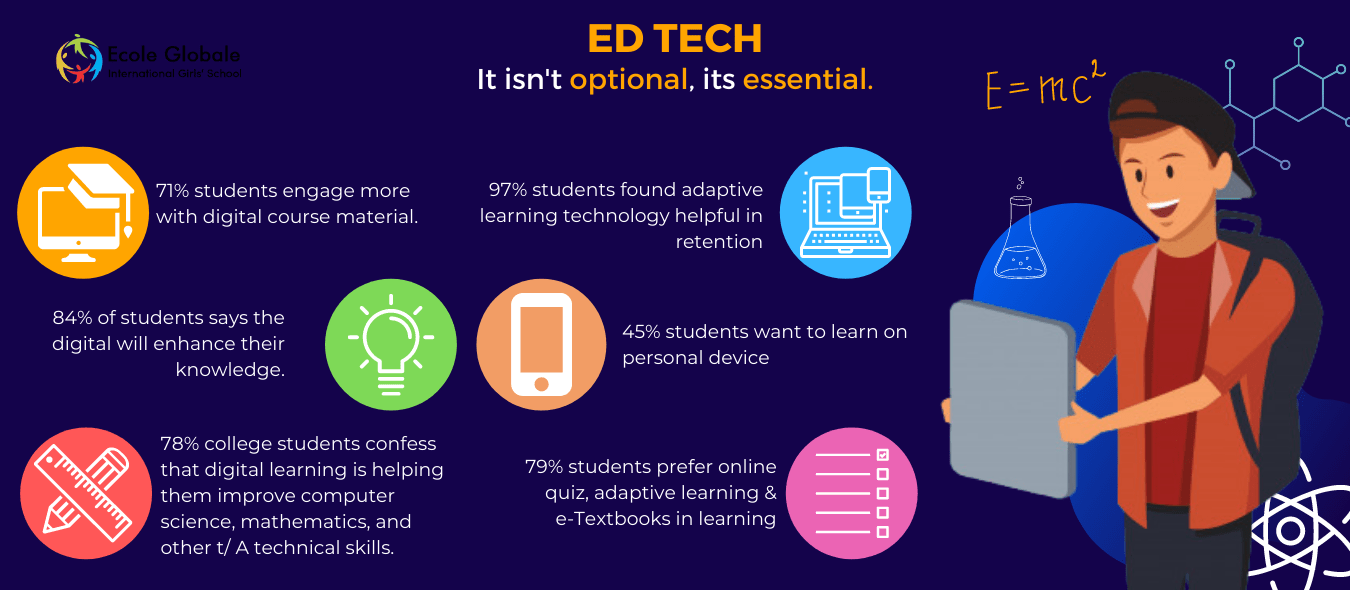The Growth Of Ed-Tech
Indeed, even before COVID-19, e-learning was an industry that was developing dramatically, particularly getting pace throughout the most recent five years or somewhere in the vicinity. In any case, the unexpected development of the pandemic incited every one of the schools to select online training to keep away from instructive and learning misfortune for youngsters. The EdTech business along these lines developed and advanced surprisingly fast, which might have required years!
Importance Of Ed-Tech
The EdTech area is good to go to assume a basic part in guaranteeing that quality training arrives at understudies the nation over, paying little heed to the topographical area, financial obstructions, or outer conditions. Pandemic occasions have underlined the way that vigorous computerized training is not an extravagance yet a total need for schools and understudies the same. Throughout the long term, various advancements and e-learning patterns have driven significant changes in the schooling space. EdTech has seen an upsurge and is relied upon to be the new typical later on too. As indicated by a KPMG study, India is at present home to more than 3,500 EdTech new businesses, and online instruction in India could be valued at $1.96 billion by 2021.
In 2021, Big Data and man-made brainpower are relied upon to assume a major part. It is, as of now, being viewed as empowering schools to convey a superior nature of the training — from conveying profoundly captivating exercises that are better perceived by understudies to performing more instinctive fitness evaluations to control understudies towards significant vocation alternatives. Computer-based intelligence and Big Data are probably going to acquire significantly ground-breaking changes informal training.
Limitations of Ed-tech In India
In nations like India, with a colossal advanced hole and enormous disparity in quality and amount of tech accessible to understudies at home, schools will assume a crucial part. Making training accessible to the individuals who can’t get to it will be the obligation of physical schools. Divided school visits and cooperation with educators and advisors will be expected to adjust the limits of Edtech. Schools need to move away from a video call-based framework and give a biological system helpful for learning. Various schools like boarding schools in Dehradun move away from these video call-based frameworks for learning. Should incorporate investigation (guaranteeing student advancement is being followed), the alteration of substance to meet the differential adapting needs, and the production of a framework that guarantees that instructors are being observed and ceaselessly prepared.
Further, an investigation should be planned to Individual Education Programs (IEPs) to assist the individuals who with playing out a level not quite the same as which they concentrate in, or experience issues in understanding certain ideas. Accordingly, an advantageous blend of the two will be the center way for India. In the coming months, rules and guidelines should be drafted to separate the parts of EdTech and schools.
Training is a reformist acknowledgment of our ignorance. Indian families are surrendering the stone-age customs today and are slanting towards saving and spending to instruct their children. From a child to a grown-up, everybody has perceived that the best way to financial improvement is singular learning. With the most recent patterns of game-based learning, social-based versatile learning and distributed computing, and so on doing adjusts, the more noteworthy scene of EdTech is noticeable to all. In India, most obstructions to training appear to be social and social; however, sheer interest for new models of post-auxiliary instruction will ideally overwhelm any constraint. Further, the worldwide diaspora of Indian tech business people can demonstrate an eminent asset in the making of 21st-century instructive innovation organizations.
How To Address The Issue
India significantly needs to improve its efficiency, which is conceivable just through schooling. Youth, the main impetus of India, will bit by bit of interest for more post-optional training openings. To satisfy these needs, a change in outlook towards on the web, mixed and far off learning, will bring about productive freedoms for instruction suppliers. Despite the fact that there is an expansion in goals for employable instruction from all areas of the general public, we need a secluded change in the Indian Education framework which can give abilities and practical skills as opposed to conveying” a “piece of paper.” What sounds like a toll is that because of dull acknowledgment and compensation of the showing calling, we need quality instructing without which any endeavors to improve the framework can go for a throw. From advanced mobile phones and PCs to interpersonal interaction and elective universes, singular decisions and exercises are changing the general public overpoweringly. Portable learning is the new pattern because of which the nation is set to jump grounds based on advanced education to web-based learning. Both Mobile appropriation and internet learning together make up a cooperative interaction. With expanding the number of portable endorsers in India, the innovation has a huge expected which, whenever embraced and comprehended, will convey incredible outcomes.
Conclusion
Individuals reflexively oppose change, and while banter seethes, activities get impeded in the discussion. In any case, any development requires an impermanent loss of safety. Thus, teachers should invite the change and help work with objectives and cast a dream for understudies that will inspire them to think bigger, yet additionally their convictions in regards to what is conceivable. As indicated by speakers throughout the planet, the neE’S E’S of instruction is: Enabled, Engaged, and Empowered.









